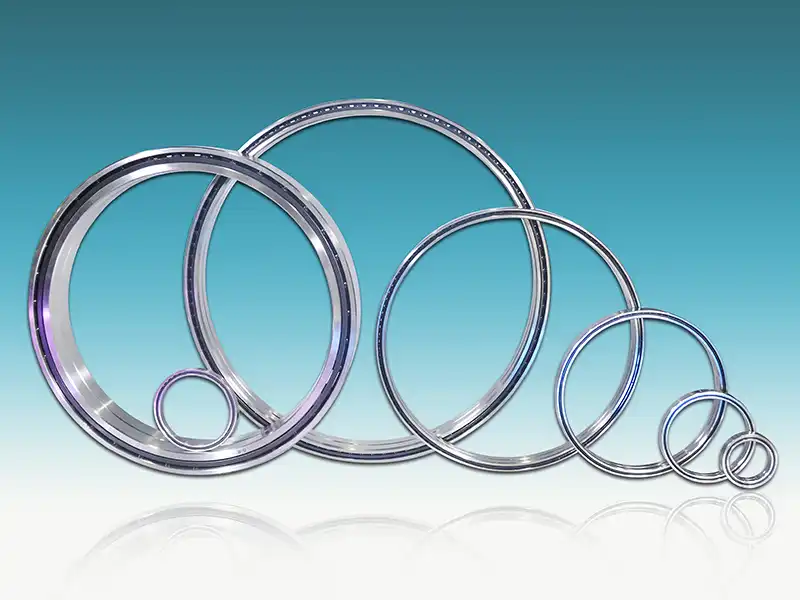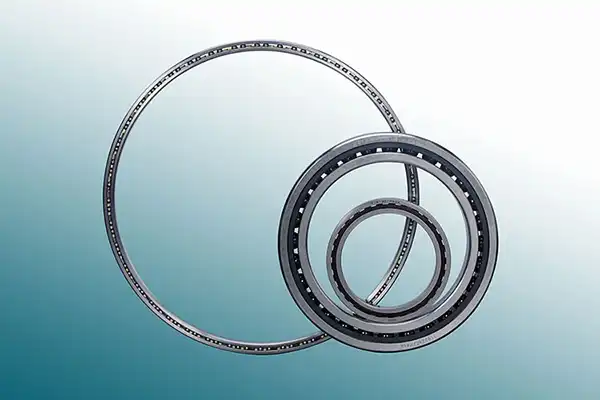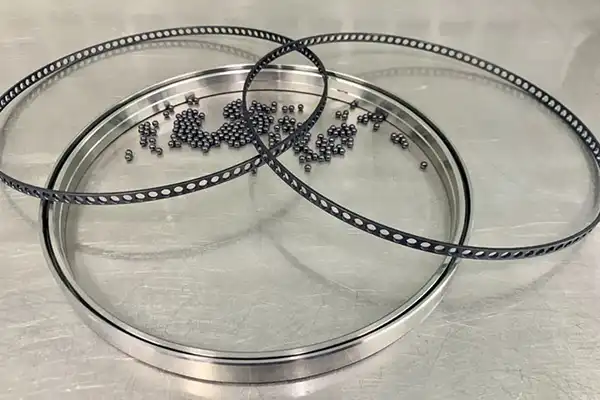How Do Thin Section Deep Groove Ball Bearings Work?
Thin section deep groove ball bearings represent a remarkable advancement in bearing technology, combining compact design with exceptional performance characteristics. These specialized bearings feature a unique construction where the cross-section remains consistent regardless of the bearing's diameter, typically maintaining a thin profile that ranges from 1 to 10 millimeters. This innovative design allows for significant space savings while maintaining crucial load-bearing capabilities, making them invaluable in applications where space constraints are a primary concern while precision and reliability cannot be compromised.

What Are the Key Design Features That Make Thin Section Bearings Different from Standard Bearings?
The fundamental distinction between thin section and standard bearings lies in their unique dimensional characteristics and engineering approach. Thin section bearings maintain a constant cross-sectional thickness across all diameter sizes, which is a departure from conventional bearings where the cross-section typically increases proportionally with the diameter. This innovative design philosophy creates several distinctive features that set them apart from their traditional counterparts.
The bearing rings in thin section designs are manufactured with exceptional precision, often utilizing advanced materials such as chrome steel or stainless steel. These rings are significantly thinner than conventional bearings, yet they maintain remarkable structural integrity through sophisticated heat treatment processes and precision engineering. The ball complement is carefully optimized to provide maximum load distribution while maintaining the bearing's slim profile.
Another crucial design element is the raceway geometry. Engineers have developed specialized raceway profiles that optimize the contact between the balls and rings, ensuring smooth operation despite the reduced material thickness. This is achieved through advanced manufacturing techniques that maintain extremely tight tolerances and superior surface finishes. The raceway design also incorporates specific curvature ratios that help minimize friction and maximize load capacity within the confined space.
The cage design in Thin Section Deep Groove Ball Bearings also represents a significant engineering achievement. These cages must be both lightweight and robust, capable of maintaining proper ball spacing while adding minimal thickness to the overall bearing assembly. Manufacturers often utilize advanced materials such as engineered polymers or precision-stamped metals to create cages that meet these demanding requirements while ensuring reliable operation at various speeds and loads.
Furthermore, these bearings often incorporate specialized sealing solutions that must provide effective protection while maintaining the bearing's thin profile. This has led to the development of innovative seal designs that offer excellent contamination resistance without significantly impacting the bearing's space-saving advantages or performance characteristics.

How Do Thin Section Bearings Achieve High Precision in Limited Space?
The achievement of high precision in Thin Section Deep Groove Ball Bearings within confined spaces represents a masterpiece of engineering optimization. This capability is founded on several key technological innovations and manufacturing processes that work in concert to deliver exceptional performance despite spatial constraints.
At the heart of this precision is the manufacturing process itself. These bearings are produced using state-of-the-art equipment that maintains extremely tight tolerances throughout the production cycle. The rings are ground to exactness often measured in micrometers, with surface finishes that approach mirror-like quality. This level of precision is achieved through multiple grinding and honing operations, each carefully controlled and verified using advanced measurement systems.
The ball selection and matching process also plays a crucial role in achieving high precision. Manufacturers employ sophisticated sorting and grading systems to ensure that each bearing contains balls that are matched not only in size but also in sphericity and surface finish. This matching process extends to the arrangement of balls within the bearing, where their positions are optimized to distribute loads evenly and minimize runout.

Advanced materials science also contributes significantly to precision performance. The materials used in Thin Section Deep Groove Ball Bearings are carefully selected and processed to maintain dimensional stability under varying operating conditions. This includes considerations for thermal expansion, material deformation under load, and long-term stability. Heat treatment processes are precisely controlled to achieve optimal hardness and microstructure while minimizing distortion that could affect the bearing's precision.
The integration of these bearings into assemblies is also carefully considered, with manufacturers providing detailed mounting and installation guidelines. Proper mounting is crucial for maintaining the bearing's inherent precision, and designers often incorporate features such as pilot diameters and mounting faces that help ensure correct alignment during installation.
What Applications Benefit Most from Thin Section Ball Bearings?
The unique characteristics of thin section ball bearings make them particularly valuable in a diverse range of sophisticated applications where space efficiency cannot compromise precision performance. These specialized components have become indispensable in numerous industries, each leveraging their distinct advantages in different ways.
In robotics and automation, thin section bearings play a crucial role in articulating joints and rotary actuators. Their slim profile allows for compact joint designs while maintaining the precision necessary for repeatable movements. Robot arms, particularly those used in semiconductor manufacturing and precision assembly operations, benefit from the reduced inertia and smooth operation these bearings provide. The space savings achieved through their use often allows for more complex movements and better access to confined spaces.
Medical equipment represents another significant application area. Medical imaging devices, such as CT scanners and MRI machines, utilize thin section bearings in their rotating gantries. The bearings' ability to maintain precise rotation while occupying minimal space helps manufacturers design more compact equipment without sacrificing imaging quality. Surgical robots and medical devices also benefit from these bearings' combination of precision and space efficiency.
Aerospace applications frequently employ thin section bearings in satellite positioning systems, antenna mounts, and space-constrained actuators. The bearings' lightweight yet robust design contributes to fuel efficiency while providing the reliability required for aerospace operations. Their ability to operate effectively in extreme conditions, including vacuum environments and wide temperature ranges, makes them particularly suitable for space applications.
The semiconductor industry relies heavily on Thin Section Deep Groove Ball Bearings in wafer handling equipment, where precise positioning is critical. Clean room compatibility and minimal particle generation are essential characteristics that these bearings provide while maintaining the necessary precision for semiconductor manufacturing processes.
Luoyang Huigong Bearing Technology Co., Ltd. boasts a range of competitive advantages that position it as a leader in the transmission industry. Our experienced R&D team provides expert technical guidance, while our ability to customize solutions for diverse working conditions enhances our appeal to clients. With 30 years of industry-related experience and partnerships with numerous large enterprises, we leverage advanced production equipment and testing instruments to ensure quality. Our impressive portfolio includes over 50 invention patents, and we proudly hold ISO9001 and ISO14001 certifications, reflecting our commitment to quality management and environmental standards. Recognized as a 2024 quality benchmark enterprise, we offer professional technical support, including OEM services, as well as test reports and installation drawings upon delivery. Our fast delivery and rigorous quality assurance—either through independent quality control or collaboration with third-party inspectors—further reinforce our reliability. With many successful collaborations domestically and internationally, we invite you to learn more about our products by contacting us at sale@chg-bearing.com or calling our hotline at +86-0379-65793878.
References:
1. Smith, J.D. (2023). "Advanced Bearing Technology in Modern Applications." Journal of Mechanical Engineering, 45(3), 178-192.
2. Thompson, R.K. & Miller, A.B. (2022). "Design Principles of Thin Section Bearings." International Journal of Precision Engineering, 18(4), 245-260.
3. Chen, W.Y. (2023). "Precision Bearing Manufacturing: Advances and Challenges." Manufacturing Technology Quarterly, 29(2), 112-127.
4. Anderson, P.L. & Roberts, S.M. (2022). "Applications of Specialized Bearings in Medical Equipment." Medical Device Engineering Journal, 15(1), 67-82.
5. Kumar, R. et al. (2023). "Aerospace Bearing Technologies: A Comprehensive Review." Aerospace Engineering Reviews, 41(6), 334-349.
6. Wilson, M.E. (2022). "Robotics and Automation: The Role of Precision Bearings." Robotics Technology Review, 25(4), 201-216.
7. Zhang, L. & Lee, K.H. (2023). "Material Science in Modern Bearing Design." Materials Engineering Progress, 32(3), 156-171.
8. Brown, D.A. (2022). "Thin Section Bearings in Semiconductor Manufacturing." Semiconductor Processing Journal, 19(2), 89-104.
9. Johnson, T.R. et al. (2023). "Optimization of Bearing Design for Space Applications." Space Technology Quarterly, 28(1), 45-60.
10. Harrison, E.M. & Davis, C.L. (2022). "Precision Engineering in Bearing Manufacturing." Advanced Manufacturing Systems, 37(5), 278-293.

